Abstract
Long-lasting Sr4Al14O25:Eu2+,Dy3+ phosphor beads were prepared with inorganic sodium silicate binders and coated to support Ag-doped TiO2 catalyst by the sol–gel coating method. Energy dispersive spectroscopy and X-ray photoelectron spectroscopy confirmed that Ag and TiO2 were loaded on the bead surface. Photocatalytic degradation of toluene volatile organic compound was evaluated under ultraviolet and visible light through 410 nm filters. The photocatalyst/phosphor beads of Ag-TiO2/Sr4Al14O25:Eu2+,Dy3+ decorated with 0.035 M Ag in N2 and N2-H2 atmospheres exhibited higher photocatalytic efficiencies compared with beads heat treated in air. A low amount of Ag impregnation and the reducing atmosphere of N2/N2-H2 were beneficial for enhancing photocatalytic efficiency because Ag-doping in TiO2 imparted low energy levels for visible light sensitization. The synthesized powder-free beads possess compressive strength for possible applications, and easy recovery of the photocatalysts is beneficial for preventing any secondary pollution of nano-powders.
1. Introduction
Titanium dioxide (TiO2) nanoparticles (NPs) are photoactive to combat air and water pollutants under ultraviolet (UV) activation. To date, several studies have been conducted to enable the sensitization of visible light by TiO2 NP [1]. The prevalent approaches for extending TiO2 absorption edge are doping with metals/non-metals [2,3] and coupling with metal oxides [4] or noble metals [5,6]. The effect of coupling 3-composites was also studied and reported to show that TiO2 forms heterojunctions in the presence of coupling TiO2/g-C3N4/rGO compounds [7]. One of the cost-effective practical techniques of doping and coupling TiO2 is the wet process method. The disadvantage of coupling two or more NP composites is uncontrollable agglomeration in wet processes. This results in the incorporated phases being dominant and even deterioration of photocatalytic efficiencies.
In metal doping of TiO2, Ag is among the most studied materials owing to its antibacterial property and 3d energy level, which induces low energy states in the TiO2 conduction band. Doping TiO2 with Ag NP to improve TiO2 sensitivity to visible light has been reported to be effective in enhancing photocatalytic properties [8]. However, several studies were conducted in the slurry type of reactor, where detachment of Ag NP and leaching problems limited the reusability of the TiO2-Ag NP in the slurry reactor [9]. Much research focuses on doping Ag on the TiO2 NP surface [10].
Nowadays, many researchers in this field are working towards the commercialization of TiO2 nanoparticles (NPs) in water and air purification systems [11,12,13]. However, owing a to high specific surface-to-volume ratio, TiO2 NPs require immobilization on substrates for practical application [14,15]. There are studies where TiO2 NPs are practically immobilized on stainless steel mesh [16], glass slides [17], glass mesh [18], quartz substrate [19], concrete [20], coconut fibers [21], and Sr4Al14O25:Eu2+,Dy3+ phosphor beads [22]. One merit for immobilizing TiO2 is reusability and a less tedious recovery for the catalysts, even in slurry reactors. Furthermore, TiO2 on the substrate is applicable for continuous airflow type of reactors facilitating air cleaning performances [23]. Coating TiO2 on substrates eliminates several processes to reduce particle agglomeration, which is cost-effective for the catalyst. Most importantly, crystalline phases are confined on the support surface and this improves the formation of inter-particle heterojunction. However, in hydraulic systems, catalysts suffer from hydro-abrasion during photoreaction mixing [24]. Meanwhile, sampling the photocatalysts in air environments minimizes the antifouling of the catalyst [25]. There has been little research on evaluating the photocatalytic performance of TiO2 supported on a substrate decorated with Ag NP.
The reusability of a catalyst depends on physical and chemical stability after the photocatalytic reaction. Crystalline substrates such as long-lasting Sr4Al14O25:Eu2+,Dy3+ phosphor beads have been reported to show stable support and photocatalytic activity in benzene [22]. Long-lasting phosphors are reported to enhance light harvesting and improve photocatalytic efficiencies through heterojunctions with TiO2 NP. There is a need to determine the optimum coating conditions on long-lasting phosphors owing to the afterglow characteristic, which is affected by the presence of other elements on the surface [26,27]. The afterglow property may aid the recovery of catalyst supports from photocatalytic reaction mixtures in large-scale applications. Up to now, there have been no reports of the photocatalytic performance of a TiO2 NP support on long-lasting phosphor beads doped with varying amounts of Ag.
In this study, long-lasting phosphor beads were synthesized from inorganic binder Na2SiO3 and decorated with Ag/TiO2. The photocatalytic performance was evaluated at various Ag-molar concentrations and the effect of reducing atmospheres. The mechanical strength of phosphor bead substrates was evaluated to confirm whether the beads are mechanically stable for reusability.
2. Results
X-ray diffraction spectra (XRD) of 0.035 M Ag-TiO2/phosphor is shown in Figure 1 as compared to Joint Committee on Powder Diffraction Standards (JCPDS) cards for (a) Sr4Al4O2(Al10O23), (b) AgO, and (c) TiO2. The Ag-doped TiO2/phosphor exhibited high crystallinity as indicated by intense XRD spectra. All the major peaks were matched and indexed in reference to Sr4Al4O2(Al10O23). However, only the peak at 27.0° is referenced to TiO2 rutile JCPDS 75-1753. While the AgO and TiO2 peaks coincided with the Sr4Al4O2(Al10O23) peaks (Figure 1b,c).
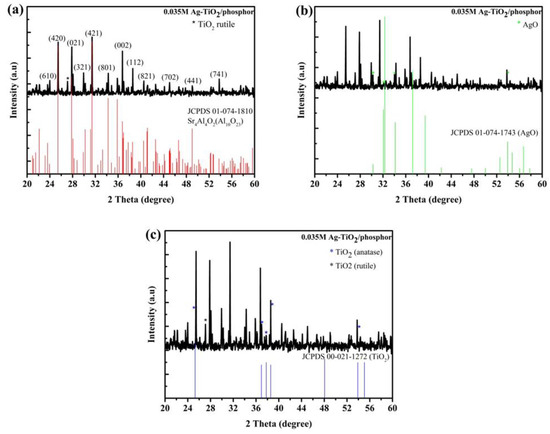
Figure 1.
XRD spectra for 0.035 M Ag-TiO2/phosphor compared to JCPDS for (a) Sr4Al4O2(Al10O23), (b) AgO, and (c) TiO2.
Scanning electron microscopy (SEM) images of (a) Sr4Al14O25:Eu2+,Dy3+, (b) TiO2/Sr4Al14O25:Eu2+,Dy3+, (c) Ag-TiO2/Sr4Al14O25:Eu2+,Dy3+, and (d) AgO on TiO2/Sr4Al14O25:Eu2+,Dy3+ photocatalyst/phosphor beads are shown in Figure 2. Phosphor bead morphology after drying at 100 °C consists of angular submicron particles of irregular sizes ranging from 1 to 10 μm with pore space. The TiO2-coated beads exhibit a spherical shape owing to the TiO2 coating. With Ag-doping, silver oxide appears as white spots decorated on the TiO2/Sr4Al14O25:Eu2+,Dy3+ beads. After a two-step coating of Ag and TiO2, the bead surface inter-particle porosity is covered over. However, thermal cracks and confined micro-pores result from heat treatments at 450 °C after the Ag and TiO2 coating processes. Figure 2d shows a high-resolution SEM image of AgO nanoparticles on phosphor and the respective supplementary images for energy dispersion spectroscopy (EDS) are shown in Figure S1a,b. The AgO nanoparticles were the brightest particles in Figure 2d (as indicated by arrows) after scanning EDS map with the highest Ag in back-scattering mode.
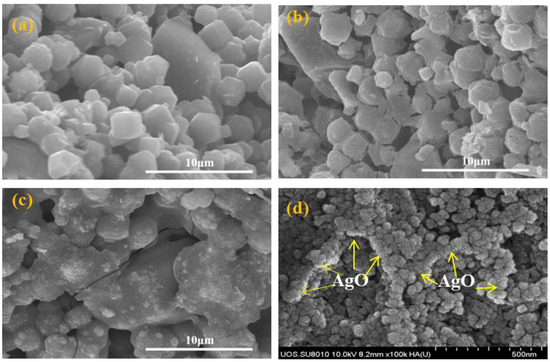
Figure 2.
SEM images of phosphor beads (a) Sr4Al14O25:Eu2+,Dy3+, (b) TiO2/Sr4Al14O25:Eu2+,Dy3+, (c) Ag-TiO2/Sr4Al14O25:Eu2+,Dy3+, and (d) AgO on TiO2/Sr4Al14O25:Eu2+,Dy3+.
Mapping analysis for the distribution of the elements on the bead surface and energy dispersion spectroscopy (EDS) spectra is shown in Figure S1c,d, respectively. Details of the elemental composition of the Sr4Al14O25:Eu2+,Dy3+ phosphor bead and the atomic percent confirming the presence of O, Na, Al, Si, and Sr are shown in Table 1. The silicon content of 14.81 atom percent originated from the Na2SiO3 inorganic binder. However, Eu and Dy were undetected because they are embedded in the core matrix and their atomic percent is also small when compared with the bulky bead surface.

Table 1.
Elemental analysis for Sr4Al14O25:Eu2+,Dy3+ phosphor beads.
Elemental compositions for TiO2/Sr4Al14O25:Eu2+,Dy3+ photocatalyst/phosphor beads are shown in Table 2. The composition of 2.71 atom percent Ti merely confirms that the coating process impregnates the phosphor surfaces with TiO2 particles. The remaining atomic composition is for the bead surface, namely O, Na, Al, Si, and Sr. Eu and Dy were below the detection limit, as also observed in Table 1, because of the bulky structure of the bead. The elemental mapping and EDS spectra for this sample are shown in Figure S1e,f, respectively.

Table 2.
Elemental analysis for TiO2/Sr4Al14O25:Eu2+,Dy3+ photocatalyst/phosphor beads.
Elemental compositions of Ag-TiO2/Sr4Al14O25:Eu2+,Dy3+ photocatalyst/phosphor beads are shown in Table 3. The amount of Ag-doped and Ti on phosphor was 1.30 and 2.21 atom percent, respectively. As mentioned in Table 1 and Table 2, the rare earth ions Eu and Dy were below the detection limit. The EDS mapping for Ag-doped TiO2/Sr4Al14O25:Eu2+,Dy3+ beads and the corresponding spectra are shown in Figure S1g,h, respectively.

Table 3.
Elemental analysis for Ag-TiO2/Sr4Al14O25:Eu2+,Dy3+ photocatalyst/phosphor beads.
Compressive stress averages for the Sr4Al14O25:Eu2+,Dy3+ phosphor photocatalyst/beads are shown in Table 4. The phosphor beads show the highest average compressive strength of 15.36 kgf compared with the TiO2-coated and Ag/TiO2-beads with 8.71 and 5.80 kgf, respectively. This is a result of the thermal cracks observed in the SEM images in Figure 2 that were caused by heat treatment procedures conducted after the coating processes. Despite the stress strain curves shown in Figure S2a–c, the beads withstood compressive strength above 5 kgf. Therefore, the beads are reusable because mechanically they are able to endure fragmentation during the handling and packaging process.

Table 4.
Compressive strength averages for Sr4Al14O25:Eu2+,Dy3+ phosphor beads.
X-ray photoelectron spectroscopy (XPS) spectra of (a) TiO2/Sr4Al14O25:Eu2+,Dy3+ and (b) Ag-TiO2/Sr4Al14O25:Eu2+,Dy3+ photocatalyst/phosphor beads are shown in Figure 3. The depth profile of TiO2/Sr4Al14O25:Eu2 +,Dy3+ photocatalyst/phosphor beads exhibits the elements of O and Ti as the highest on the surface, while Al and Sr increase with etching time (Figure 3a,b). This shows that the TiO2 NPs are loaded at the surface while Sr and Al are in the core of the bead. The composition of Ag varied from 0.76 at the surface to 0.48 atomic percent after 3000 s etching (supplementary Tables S1 and S2).
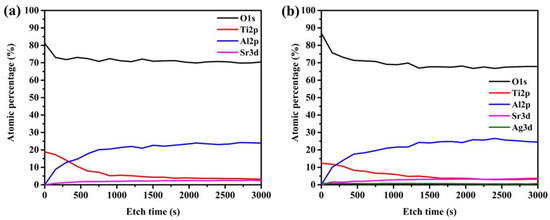
Figure 3.
XPS depth profile spectra of (a) TiO2/Sr4Al14O25:Eu2+,Dy3+ and (b) Ag-TiO2/Sr4Al14O25:Eu2+,Dy3+ photocatalyst/phosphor beads.
XPS spectra of the photocatalyst/phosphor bead surface of 0.035 M Ag decorated TiO2/Sr4Al14O25:Eu2+,Dy3+ are shown in Figure 4 as (a) survey, (b) Ti 2p, (c) Ag 3d, and (d) O 1s. The spectra show peaks of Na 1s, O 1s, Ti 2p, Ag 3d5, C 1s, and Si 2p (Figure 4a). Except for C impurity from the instruments and the environment, all the elements are part of the Sr4Al14O25:Eu2+,Dy3+ bead/TiO2/Ag composite. The atomic compositions of the respective elements are provided in supplementary Tables S3 and S4. Ti 2p spectra for the Ag-TiO2/Sr4Al14O25:Eu2+,Dy3+ bead are shown in Figure 4b. The binding energy of 464 and 458 eV confirms the bonding of Ti to O. Atomic percent for TiO2 is 2.7% (supplementary Table S2). The spectrum has two peaks at 369.5 and 375.7 eV, which correspond to the core level of Ag 3d3/2 and Ag 3d5/2 (Figure 4c). These peaks are referenced to Ag2O compounds owing to Ag and O bonds, where at Ag0 and Ag+ exist in the deconvoluted peak of 360 to 370 eV [28]. The spectra for O 1s with a maximum binding energy peak at 532 eV are shown in Figure 4d.
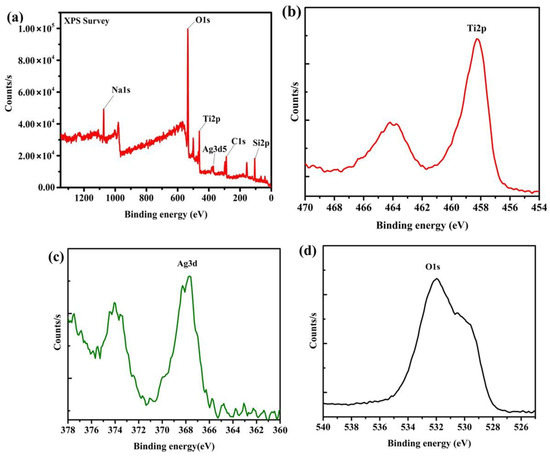
Figure 4.
XPS spectra on the surface of Ag-TiO2/Sr4Al14O25:Eu2+,Dy3+beads (a) survey, (b) Ti 2p, (c) Ag 3d, and (d) O 1s.
Photoluminescence (PL) spectra of the TiO2/Sr4Al14O25:Eu2+,Dy3+ beads containing varying amounts of Ag-doping in Figure 5 show that the maximum emission from the phosphor beads peaks at 490 nm. TiO2 without Ag on Sr4Al14O25:Eu2+,Dy3+ phosphor beads exhibits about a 5% decrease in luminescence intensity compared with Sr4Al14O25:Eu2+,Dy3+ phosphor beads. The phosphor beads with and without TiO2 coating were inserted as control samples. The emission peak intensity decreased as the doping amount of Ag increased from 0.017 M to 0.14 M. Phosphor emission centers are localized at the surface, such that only transparent materials effectively emit light. However, TiO2 and AgO seem to partially absorb and simultaneously hinder the propagation of emitted light from phosphor photons.

Figure 5.
Photoluminescence (PL) emission spectra for TiO2/phosphor beads doped with varying Ag content.
The PL spectra of the Sr4Al14O25:Eu2+,Dy3+ phosphor beads coated with/without Ag and TiO2 calcined in (air, N2 or N2-H2) unique atmospheres are shown in Figure 6. In comparison with other beads, Sr4Al14O25:Eu2+,Dy3+ phosphor maintains the most extraordinary intensities, followed by the TiO2-coated phosphor beads. Evidently, Ag-doped beads coated in an N2 environment show a higher luminescence than ones treated in N2-H2 and air atmospheres. As can be observed in SEM images, the coating of phosphor with Ag-sol showed AgO nanoparticle clusters along the phosphor surface. On this account, AgO clusters cause light obstruction from the emitted phosphor photons. Ag calcined in air shows the least peak intensity, undoubtedly owing to possible significant amounts of AgO on the bead surface.
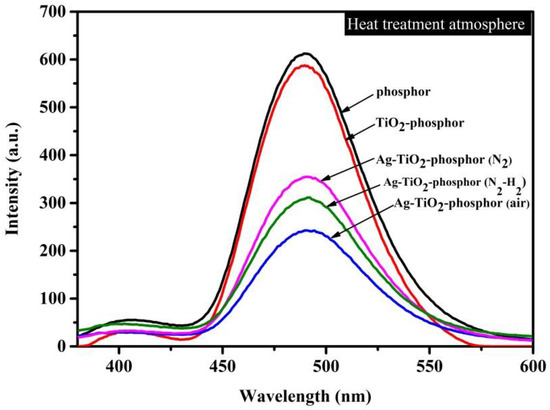
Figure 6.
PL spectra for Ag-TiO2/Sr4Al14O25:Eu2+,Dy3+ photocatalyst/phosphor beads calcined in air, N2, and N2-H2 atmospheres.
The variation of toluene photodegradation over the Ag-doped TiO2/phosphor beads under a UV light source is shown in Figure 7. These beads were calcined in the N2 atmosphere. The photocatalysts exhibit photocatalytic activity reaching over 80% efficiency in 1 h. Although the 0.035 M doped samples displayed an outstanding photocatalytic performance, the 0.14 M doped TiO2 phosphor beads exhibited less efficiency as an indication of the undesirable AgO barrier between the TiO2/Sr4Al14O25:Eu2+,Dy3+ interface (enlarged Figure 7b, extracted from Figure 7a). The variation of toluene degradation in the presence of commercial TiO2 (for 1-h cycle) was also inserted in Figure 7b. Clearly, commercial TiO2 exhibits 70% efficiency as compared to phosphor/TiO2 composites with above 80% efficiency in a 1-h cycle. The reason being the Ag-doping and phosphor bead support improves light sensitization.
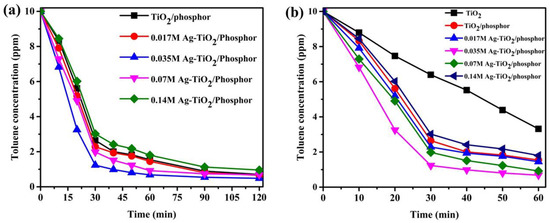
Figure 7.
Photocatalytic degradation of toluene over Ag-TiO2/Sr4Al14O25:Eu2+,Dy3+ photocatalyst/phosphor beads under UV light activation.
The photodegradation of toluene with the Ag-doped TiO2/phosphor beads under a visible light source is shown in Figure 8. The photoreactions exhibited a degradation of toluene in a 240-min cycle, where the 0.035 M Ag doped sample shows the highest photocatalytic efficiency and the 0.14 M sample is the lowest. In detail, the 0.035 M degrades over 70% while the 0.14 M reaches only 40% efficiency in 120 min (enlarged Figure 8b, extracted from Figure 8a). Photodegradation of toluene in TiO2 commercial powder (Figure 8b) shows that TiO2 on its own is not activated by visible light owing to the large band gap of 3.2 eV. However, by coupling with phosphor and with additional Ag-doping, the composites exhibit significant photocatalytic activity. The reason for the fastest photolysis rate in 0.035 M Ag-TiO2/Sr4Al14O25:Eu2+,Dy3+ photocatalyst/phosphor beads is enhanced sensitization by Ag ions causing the overall electron–hole generation and separation that occurs unexpectedly with visible light.
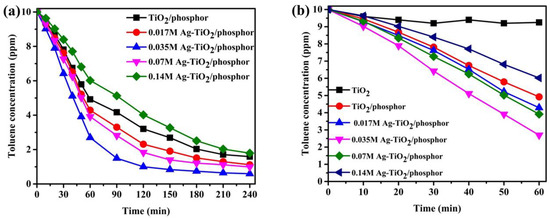
Figure 8.
Photocatalytic degradation of toluene over Ag-TiO2/Sr4Al14O25:Eu2+,Dy3+ photocatalyst/phosphor beads under visible light irradiation.
Photodegradation of toluene with the 0.035 M Ag-doped TiO2/phosphor beads heat treated in air, N2, and N2-H2 as activated by visible light is shown in Figure 9. The photocatalytic performance in commercial TiO2 powder was inserted for comparisons. As discussed in Figure 8b, TiO2 is not activated by visible light. Thus, only adsorption of the toluene volatile organic compound (VOC) occurs on the commercial TiO2 nano powders. At the 30-min sampling intervals, samples calcined in N2 and N2-H2 gas exhibited about 90% efficiency while heat treated in air samples maintained about 70% efficiency. The samples heat treated in air exhibited 20% points less efficiency than those in the reducing atmosphere. Consequently, the reducing atmosphere shows improved photocatalytic efficiencies while the oxidizing condition increases AgO oxides, which become barriers to photocatalytic enhancement.
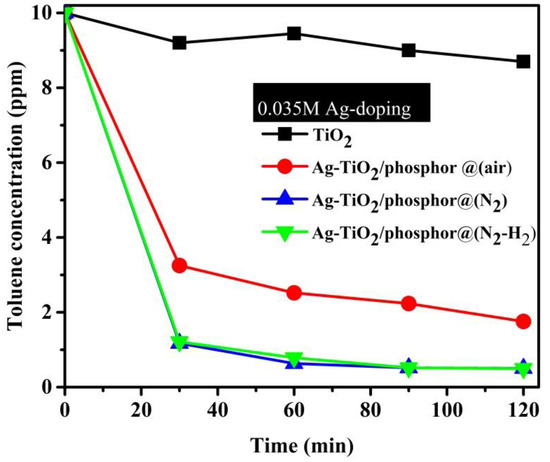
Figure 9.
Photocatalytic degradation of toluene with the 0.035M Ag-doped TiO2/phosphor beads over visible light irradiation.
3. Discussion
Sr4Al14O25:Eu2+,Dy3+ phosphor beads synthesized from sodium silicate binders revealed thermal cracks as an effect of heat treatment. This is prevalent with sodium silicate additive because the glass phases transform and cause inter-particle encapsulation. However, owing to different thermal expansions, cracks and voids form within sintered specimens. As observed, the detrimental effects of the cracks and pores were low compressive strength because the cracks and pores act as centers of weakness as fracture points. One advantage of porosity and micro-cracks is the possible active sites formed during incipient wetness impregnation. As observed in depth profiling for 3000 s, the Ag:Ti ratio was observed from 12:0.76 at the surface to 3.16:0.48. Therefore, the cracks and micro-pores were loaded with Ag/TiO2, which resulted in enhanced photocatalytic efficiencies.
The amount of Ag-TiO2 on the phosphor surface and heat treatment in air, N2, and N2-H2 affect photoluminescence emission. This is a common phenomenon on long-lasting phosphors coated with non-luminescence materials. Nanoparticles on the surface of phosphor block the emitted photons. The photocatalytic efficiencies were enhanced in 0.035 M as optimum Ag concentration, while the efficiencies were lower on 0.14 M. This is a possible indication of excess Ag-O on the phosphor surface, which acts as a barrier to luminescent light. Additionally, the inter-phosphor-TiO2 junction is increased, which merely renders phosphor inefficient to TiO2 performance [23].
The effect of heat treatment condition on photocatalytic efficiencies of 0.035 M Ag (Figure 9) is elaborated on as the best activity in N2 and N2-H2 over-oxidizing atmospheres. The reducing atmospheres enhance oxygen deficient Ag, which easily migrates into Ti at interstitial sites. While in an oxidizing atmosphere, Ag crystallizes as oxygen-rich oxides that limit the chances of TiO2 doping. Thus, sensitization of UV/visible light is enhanced because of lower Fermi levels imparted by Ag-doping. Therefore, separation of electron–hole pairs is improved with Ag-doping for more superior photocatalytic efficiencies [10].
TiO2 commercial powder showed no photocatalytic variation in visible light owing to its large band gap. While under UV light activation, significant photocatalytic decomposition of toluene in TiO2 commercial powder was observed since irradiated photons activated the catalyst. Overall, the Ag-doped-TiO2/phosphor showed better photocatalytic performances than commercial TiO2 because of an improved light sensitization by phosphor support and the Ag-doping. The results in our research also confirm enhancement of photocatalytic efficiencies after Ag-doping compared to only TiO2 coating. A similar trend was reported in Ag-doped calcium aluminate phosphor/TiO2 beads [23]. The test conditions in the reference were a 75-W mercury lamp UV light and 200-W visible light incandescent lamp over a 410 nm filter. However, the photocatalytic activity of Ag-doped/TiO2-Sr4Al14O25:Eu2+,Dy3+ phosphor beads has been reported for the first time with fast photoactivity completing in 60 to 240 min under UV and visible light, respectively. Therefore, Ag-doped/TiO2-Sr4Al14O25:Eu2+,Dy3+ phosphor beads are possible candidates for alleviating volatile organic compounds.
4. Materials and Methods
4.1. Experimental
Phosphor beads were prepared using the long-lasting phosphorescent Sr4Al14O25:Eu2+,Dy3+ (Luminova BG-300M, Nemoto & Co., Ishioka-shi, Ibaraki-ken, Japan) and sodium alginate (C5H7O4·(COOH)n) solution. The alginate process for phosphor beads is described in detail elsewhere [22]. Ag-doping sol was prepared from silver nitrate (AgNO3 99.8%, Junsei Chemical Co., Tokyo, Japan). Four batches of 0.017 M, 0.035 M, 0.07 M, and 0.14 M concentration Ag-doping sol were coated batch-wise on Sr4Al14O25:Eu2+,Dy3+ phosphor beads. Each AgNO3 batch was dissolved in a beaker of 38 mL distilled H2O, 2 mL ethyl alcohol (C2H5OH 99.9%, Duksan Pure Chemicals Co., Ansan-si, Kyunggi-do, Korea) and 2 mL NH4OH (extra pure grade, Duksan Pure Chemicals Co., Ansan-si, Kyunggi-do, Korea) and stirred at 30 °C for 2 h. Sr4Al14O25:Eu2+,Dy3+ phosphor beads weighing 40 g were dip-coated in 40 mL of Ag-doping sol and filtered through a funnel. After drying in an oven at 100 °C for 6 h, the beads were placed in a closed crucible for heat treatment. Heat treatment was performed on the 40 g batches in a tube furnace (AJ-MBT6, AHJEON Industrial Co., Namyangju-si, Kyunggi-do, Korea) at 450 °C for 2 h. The heat treatment atmosphere was adjusted per batch by air, N2, and N2-H2.
TiO2-sol stock solution was prepared from 40 mL titanium tetraisopropoxide (97%, Sigma Aldrich, St. Louis, MO, USA), 200 mL ethyl alcohol (C2H5OH 70%, Daejung Chemicals, Siheung-si, Gyeonggi-do, Korea), 4 mL nitric acid (HNO3 70%, Daejung Chemicals, Siheung-si, Gyeonggi-do, Korea), and 40 mL distilled H2O. Afterwards, 40 g of Sr4Al14O25:Eu2+,Dy3+ phosphor beads were dip-coated in 40 mL of TiO2 solution, filtered and dried at 100 °C for 6 h. Ag-doped Sr4Al14O25:Eu2+,Dy3+ phosphor beads were also coated with TiO2 using a similar process. TiO2-coated beads were calcined at 450 °C for 2 h in a box furnace (DSF-7GFS, Daejung Science Co., Incheon, Korea). Images of (a) Sr4Al14O25:Eu2+,Dy3+ phosphor beads, (b) TiO2/Sr4Al14O25:Eu2+,Dy3+ phosphor beads, and (c) Ag-TiO2/Sr4Al14O25:Eu2+,Dy3+ phosphor beads are shown in Figure 10. The 4–6 mm diameter phosphor beads in Figure 10a are off-whitish while TiO2 and Ag-doped/TiO2 samples in (b) and (c) are colored greyish and yellowish-olive, respectively. Thus, Ag coating shows that it imparts a deep olive color which may reduce the light-scattering phenomenon common in whitish TiO2 surfaces.
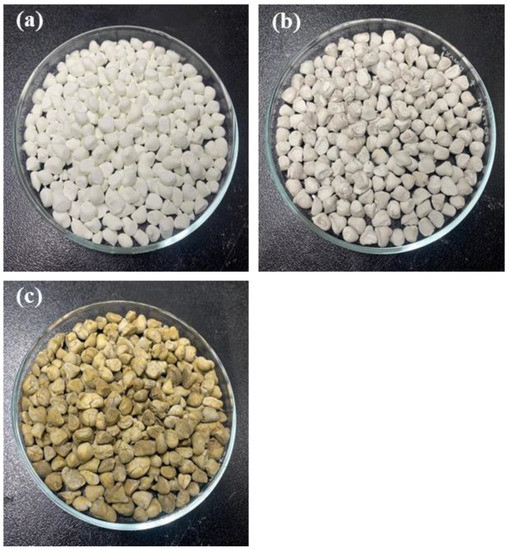
Figure 10.
Images of phosphor beads (a) Sr4Al14O25:Eu2+,Dy3+, (b) TiO2/Sr4Al14O25:Eu2+,Dy3+, and (c) Ag-TiO2/Sr4Al14O25:Eu2+,Dy3+.
4.2. Characterizations
The crystallinity of the 0.035 M Fe-TiO2/phosphor bead was analyzed by XRD with Cu Kα irradiation (Bruker AXS8 Advanced, D8 Discover, GmbH, Karlsruhe, Germany). Surface morphology and element composition were evaluated by SEM (Hitachi S4300, Tokyo, Japan), EDS (JEOL, JSM-6010PLUS, Peabody, MA, USA) and XPS (ThermoFisher Scientific, Nexsa, Waltham, MA, USA). A fluorescence spectrometer (Hitachi F4500, Tokyo, Japan) was used to measure the luminescence characteristics of the synthesized composite materials. The photodecomposition of toluene (C7H8 10.7 μmol/mol), one of the hazardous volatile organic compounds (VOCs) was analyzed by gas chromatography (GC, 7890A, Agilent Technologies Inc., Santa Clara, CA, USA).
The compressive strength of the phosphor beads was measured using a compression testing machine (Instron 3344, Instron Co., Norwood, MA, USA). The maximum compressive strength for each bead was measured using a tip of 7 cm in diameter at a constant crosshead speed of 0.5 mm/min. Two samples of Sr4Al14O25:Eu2+,Dy3+, TiO2/Sr4Al14O25:Eu2+,Dy3+, and Ag-TiO2/Sr4Al14O25:Eu2+,Dy3+ beads were evaluated for compressive strength measurements.
The toluene photodegradation experiment was performed in 1-L Teflon bags containing 40 g of TiO2/Sr4Al14O25:Eu2+,Dy3+ photocatalyst/phosphor beads and 10 ppm toluene under UV and visible light conditions. The 40 g phosphor beads were a mixture consisting of 4 mm and 6 mm diameter at 1:1 ratio, respectively. At intervals of UV (6 W, 2 fluorescent lamps, G6T5 Sankyo Denki, Sankyo Denki Co., Kanagawa, Japan) or 100 W visible light (ST55 L Ilkwang Lamp Co., Daegu, Korea) irradiation with 410 nm filters, 1 mL of toluene was sampled and injected into the GC analyzers. The lights were placed at 15 cm height illuminating the samples throughout the experiments. The light flux was measured by a Digital Lux Meter (Smart Sensor AR823). For the two photocatalytic conditions, one 100 W bulb (visible light) and two fluorescent lamps (UV light) of 6 W each emitted an average of 1200 and 30 lux at 15 cm height, respectively. For comparisons, 1 g of commercial TiO2 powder (Aeroxide TiO2 P25, Evonik, Essen, Germany) was spread on a 9.4 cm diameter quartz petri dish and tested for toluene photodegradation using similar conditions. The photocatalytic tests were conducted without any pH modifiers.
5. Conclusions
Ag-TiO2/Sr4Al14O25:Eu2+,Dy3+ photocatalyst/phosphor beads were synthesized and decorated with Ag NP prior to TiO2 coating. Depth profile etching confirmed that the Ag/Ti elements were on the surface and in the inner bead structure. Despite micro-cracks/pores, the beads showed a high compressive strength which is beneficial for reuse as photocatalyst supports. Photocatalytic performances on phosphor beads with 0.035 M Ag showed the highest photodegradation of toluene VOC in both UV and visible light activation. Compared with air and N2-H2, the reducing atmosphere of N2 preserved PL emission, which is beneficial for aesthetic afterglow and recovery of the catalyst.
Supplementary Materials
The following are available online at https://www.mdpi.com/2073-4344/11/2/261/s1, Figure S1: (a) EDS mapping for AgO on TiO2/Sr4Al14O25:Eu2+,Dy3+ phosphor bead, (b) EDS spectra and map elemental composition analysis for AgO on TiO2/Sr4Al14O25:Eu2+,Dy3+ phosphor bead, (c) EDS mapping for Sr4Al14O25:Eu2+,Dy3+phosphor bead, (d) EDS spectra for Sr4Al14O25:Eu2+,Dy3+ phosphor beads, (e) EDS mapping for TiO2/Sr4Al14O25:Eu2+, Dy3+ photocatalyst/phosphor beads, (f) EDS spectra for TiO2/Sr4Al14O25:Eu2+,Dy3+ photocatalyst/phosphor beads, (g) EDS mapping for Ag-TiO2/Sr4Al14O25:Eu2+,Dy3+ photocatalyst/phosphor, (h) EDS spectra for Ag-TiO2/Sr4Al14O25:Eu2+,Dy3+ photocatalyst/phosphor beads, Figure S2: (a) Compression strain curve for two Sr4Al14O25:Eu2+,Dy3+ phosphor beads, (b) compression strain curve for TiO2/Sr4Al14O25:Eu2+,Dy3+ phosphor beads, (c) compression strain curve for Ag-TiO2/Sr4Al14O25:Eu2+,Dy3+ phosphor beads, Table S1: Atomic percent composition for the depth profile of TiO2/Sr4Al14O25:Eu2+,Dy3+ beads etched for 3000 s, Table S2: Atomic percent composition for the depth profile of Ag-TiO2/Sr4Al14O25:Eu2+,Dy3+ beads etched for 3000 s, Table S3: Elemental composition for the etched Ag-TiO2/Sr4Al14O25:Eu2+,Dy3+ bead surface for the survey spectra, Table S4: Ag-TiO2/ Sr4Al14O25:Eu2+,Dy3+ phosphor bead surface narrow for total acquisition time of 7 min 40.25 sec.
Author Contributions
Supervision, J.-S.K.; methodology and experimentation, S.-R.E.; writing—original draft, S.M. All authors have read and agreed to the published version of the manuscript.
Funding
This work was supported by the Basic Study and Interdisciplinary R&D Foundation Fund of the University of Seoul 2019.
Conflicts of Interest
The authors declare no conflict of interest.
References
- Fujishima, A.; Rao, T.N.; Tryk, D.A. Titanium dioxide photocatalysis. J. Photochem. Photobiol. C Photochem. Rev. 2000, 1, 1–21. [Google Scholar] [CrossRef]
- Akpan, U.G.; Hameed, B.H. The advancements in sol-gel method of doped-TiO2 photocatalysts. Appl. Catal. A Gen. 2010, 375, 1–11. [Google Scholar] [CrossRef]
- Dong, F.; Wang, H.; Wu, Z.; Qiu, J. Marked enhancement of photocatalytic activity and photochemical stability of N–doped TiO2 nanocrystals by Fe3+/Fe2+ surface modification. J. Colloid Interface Sci. 2010, 343, 200–208. [Google Scholar] [CrossRef] [PubMed]
- Schubert, J.S.; Popovic, J.; Haselmann, G.M.; Nandan, S.P.; Wang, J.; Giesriegl, A.; Cherevan, A.S.; Eder, D. Immobilization of Co, Mn, Ni and Fe oxide co-catalysts on TiO2 for photocatalytic water splitting reactions. J. Mater. Chem. A 2019, 7, 18568–18579. [Google Scholar] [CrossRef]
- Karácsonyi, É.; Baia, L.; Dombi, A.; Danciu, V.; Mogyorósi, K.; Pop, L.C.; Kovács, G.; Coşoveanu, V.; Vulpoi, A.; Simon, S.; et al. The photocatalytic activity of TiO2/WO3/noble metal (Au or Pt) nanoarchitectures obtained by selective photodeposition. Catal. Today 2013, 208, 19–27. [Google Scholar] [CrossRef]
- Iqbal, A.; Ibrahim, N.H.; Rahman, N.R.A.; Saharudin, K.A.; Adam, F.; Sreekantan, S.; Yusop, R.M.; Jaafar, N.F.; Wilson, L.D. ZnO Surface Doping to Enhance the Photocatalytic Activity of Lithium Titanate/TiO2 for Methylene Blue Photodegradation under Visible Light Irradiation. Surfaces 2020, 3, 22. [Google Scholar] [CrossRef]
- Ibrahim, Y.O.; Hezam, A.; Qahtan, T.F.; Al-Aswad, A.H.; Gondal, M.A.; Drmosh, Q.A. Laser-Assisted Synthesis of Z-Scheme TiO2/rGO/gC3N4 Nanocomposites for Highly Enhanced Photocatalytic Hydrogen Evolution. Appl. Surf. Sci. 2020, 534, 147578. [Google Scholar] [CrossRef]
- Chen, H.W.; Ku, Y.; Kuo, Y.L. Photodegradation ofo-Cresol with Ag Deposited on TiO2 under Visible and UV Light Irradiation. Chem. Eng. Technol. 2007, 30, 1242–1247. [Google Scholar] [CrossRef]
- Dong, H.; Zeng, G.; Tang, L.; Fan, C.; Zhang, C.; He, X.; He, Y. An overview on limitations of TiO2-based particles for photocatalytic degradation of organic pollutants and the corresponding countermeasures. Water Res. 2015, 79, 128–146. [Google Scholar] [CrossRef] [PubMed]
- Gupta, K.; Singh, R.P.; Pandey, A.; Pandey, A. Photocatalytic antibacterial performance of TiO2 and Ag-doped TiO2 against S. aureus. P. aeruginosa and E. coli. Beilstein J. Nanotechnol. 2013, 4, 345–351. [Google Scholar] [CrossRef]
- Yadav, H.M.; Kim, J.S. Solvothermal synthesis of anatase TiO2-graphene oxide nanocomposites and their photocatalytic performance. J. Alloys Compd. 2016, 688, 123–129. [Google Scholar] [CrossRef]
- Di Paola, A.; García-López, E.; Marcì, G.; Palmisano, L. A survey of photocatalytic materials for environmental remediation. J. Hazard. Mater. 2012, 211–212, 3–29. [Google Scholar] [CrossRef] [PubMed]
- Neppolian, B.; Mine, S.; Horiuchi, Y.; Bianchi, C.L.; Matsuoka, M.; Dionysiou, D.D.; Anpo, M. Efficient photocatalytic degradation of organics present in gas and liquid phases using Pt-TiO2/Zeolite (H-ZSM). Chemosphere 2016, 153, 237–243. [Google Scholar] [CrossRef] [PubMed]
- Ao, C.H.; Lee, S.C. Enhancement effect of TiO2 immobilized on activated carbon filter for the photodegradation of pollutants at typical indoor air level. Appl. Catal. B Environ. 2003, 44, 191–205. [Google Scholar] [CrossRef]
- Saiful Amran, S.N.B.; Wongso, V.; Abdul Halim, N.S.; Husni, M.K.; Sambudi, N.S.; Wirzal, M.D.H. Immobilized carbon-doped TiO2 in polyamide fibers for the degradation of methylene blue. J. Asian Ceram. Soc. 2019, 7, 321–330. [Google Scholar] [CrossRef]
- Patil, U.M.; Kulkarni, S.B.; Deshmukh, P.R.; Salunkhe, R.R.; Lokhande, C.D. Photosensitive nanostructured TiO2 grown at room temperature by novel “bottom-up” approached CBD method. J. Alloys Compd. 2011, 509, 6196–6199. [Google Scholar] [CrossRef]
- Zhang, Z.H.; Wang, H.J.; Liang, Y.H.; Li, X.J.; Ren, L.Q.; Cui, Z.Q.; Luo, C. One-step fabrication of robust superhydrophobic and superoleophilic surfaces with self-cleaning and oil/water separation function. Sci. Rep. 2018, 8, 1–12. [Google Scholar] [CrossRef] [PubMed]
- Esterkin, C.R.; Negro, A.C.; Alfano, O.M.; Cassano, A.E. Radiation Field Inside a Reactor of Glass-Fiber Meshes Coated with TiO2. AIChE J. 2002, 48, 832–845. [Google Scholar] [CrossRef]
- Okunaka, S.; Tokudome, H.; Hitomi, Y.; Abe, R. Facile preparation of stable aqueous titania sols for fabrication of highly active TiO2 photocatalyst films. J. Mater. Chem. A 2015, 3, 1688–1695. [Google Scholar] [CrossRef]
- Koli, V.B.; Mavengere, S.; Kim, J.-S. Photocatalytic properties of TiO2-SiO2-coated concrete on toluene gas. Mater. Res. Express 2018, 5. [Google Scholar] [CrossRef]
- Lopes, F.C.S.; Rocha, M.D.G.C.D.; Bargiela, P.; Ferreira, H.S.; Pires, C.A.D.M. Ag/TiO2 photocatalyst immobilized onto modified natural fibers for photodegradation of anthracene. Chem. Eng. Sci. 2020, 227, 115939. [Google Scholar] [CrossRef]
- Sung, H.J.; Kim, B.M.; Jung, S.C.; Kim, J.S. Photocatalytic characteristics for the nanocrystalline TiO2 supported on Sr4Al14O25: Eu2+, Dy3+ phosphor beads. Adv. Mater. Lett. 2016, 7, 36–41. [Google Scholar] [CrossRef]
- Kim, J.-S.; Sung, H.-J.; Kim, B.-J. Photocatalytic characteristics for the nanocrystalline TiO2 on the Ag-doped CaAl2O4:(Eu,Nd) phosphor. Appl. Surf. Sci. 2015, 334, 151–156. [Google Scholar] [CrossRef]
- Argyle, M.D.; Bartholomew, C.H. Heterogeneous catalyst deactivation and regeneration: A review. Catalysts 2015, 5, 145–269. [Google Scholar] [CrossRef]
- Banerjee, S.; Dionysiou, D.D.; Pillai, S.C. Self-cleaning applications of TiO2 by photo-induced hydrophilicity and photocatalysis. Appl. Catal. B. Environ. 2015, 176–177, 396–428. [Google Scholar] [CrossRef]
- Liu, X.; Chen, X.; Li, Y.; Wu, B.; Luo, X.; Ouyang, S.; Luo, S.; Al Kheraif, A.A.; Lin, J. A g-C3N4@Au@SrAl2O4:Eu2+,Dy3+ composite as an efficient plasmonic photocatalyst for round-the-clock environmental purification and hydrogen evolution. J. Mater. Chem. A 2019, 7, 19173–19186. [Google Scholar] [CrossRef]
- Mavengere, S.; Kim, J.-S. Photocatalytic Properties of g-C3N4–Supported on the SrAl2O4:Eu,Dy/SiO2. Coatings 2020, 10, 917. [Google Scholar] [CrossRef]
- Firet, N.J.; Blommaert, M.A.; Burdyny, T.; Venugopal, A.; Bohra, D.; Longo, A.; Smith, W.A. Operando EXAFS study reveals presence of oxygen in oxide-derived silver catalysts for electrochemical. J. Mater. Chem. A 2019, 7, 2597. [Google Scholar] [CrossRef]
Publisher’s Note: MDPI stays neutral with regard to jurisdictional claims in published maps and institutional affiliations. |
© 2021 by the authors. Licensee MDPI, Basel, Switzerland. This article is an open access article distributed under the terms and conditions of the Creative Commons Attribution (CC BY) license (http://creativecommons.org/licenses/by/4.0/).